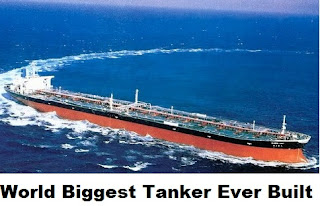Explosimeter Equipment
The Explosimeter is the name normally associated with the
instrument for measuring hydrocarbon gas in air at concentrations below the
Lower Flammable Limit. Its full name is a Catalytic Filament Combustible Gas
Indicator.
A full understanding of the construction and principle of
an Explosimeter is essential for its safe and efficient use and it is essential
that any person using this instrument carefully studies the operating manual.
There is also a detailed explanation in the ISGOTT carried on tankers.
 |
| Top Biggest Tanker |
The Explosimeter measures from 0 to 100% of the Lower
Explosive Limit (1.4% by volume).
If the gas to air mixture is above the upper explosive limit (6% by volume) the meter reading will initially rise to give a reading of 100% or above, but will rapidly fall towards zero because the mixture of gas and air in the combustion chamber is too `rich' to sustain combustion.
If the gas to air mixture is above the upper explosive limit (6% by volume) the meter reading will initially rise to give a reading of 100% or above, but will rapidly fall towards zero because the mixture of gas and air in the combustion chamber is too `rich' to sustain combustion.
The meter must therefore be constantly observed for this
phenomenon, as an apparently safe reading may be obtained when the atmosphere
is in fact highly dangerous.
Calibration checks must be carried out at two monthly
intervals and when a filament has been changed in accordance with
manufacturers’ instructions. Note that, in general, an explosimeter may be
calibrated by different gases. It is essential that the correct gas is used
otherwise an error may result. Explosimeters will not read hydrocarbon levels
in an inert atmosphere.
Oxygen
Analyzer Equipment's
According to the new law, all ships are to be supplied with a portable oxygen analyser.
This equipment is supplied for use in checking that spaces to be entered have
been properly ventilated. It is also to be used on Tankers, Gas Ships and
Chemical Carriers to check that the atmosphere of inerted tanks remains below
7%.
Two tests should be carried out on the instrument prior
to use and a permanent record of readings kept on board.
(i) Zero Adjustment
This is done by using an oxygen-free gas, such as
Nitrogen or Carbon Dioxide. Equipment is supplied for this test. Note that CO2
is paramagnetic and therefore may not give a zero reading on certain
instruments.
(ii) Span Adjustment
This must be done in FRESH AIR and the instrument
carefully checked that the reading has stabilised at 21% before the atmosphere
of any space is tested.





No comments:
Post a Comment